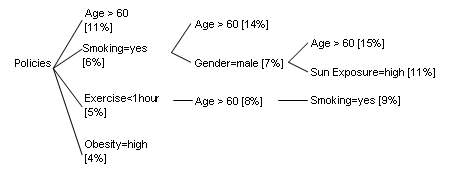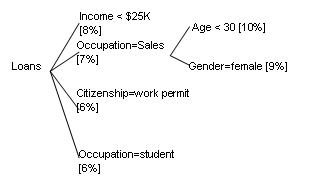|
|
|||||||||||||||
Customer Profiling
Statistical customer profiling along with demographic, geographic, and psychographic variables
is a widely practiced technique in business. For example, it can be used to determine
premium rates in insu
Combinational Factor Analysis and Combinatorial Blowout!
In conventional customer profiling methods, analysts use visualization and statistical reporting tools. These tools can work on only a few variables at a time. When applied to data with many variables like customer information, the numbers of combinations to be examined will grow combinatorially to the numbers of variables. Therefore, thorough systematic accurate analysis of such data by manual means is all but impossible. General practice is to examine only variable combinations what experts think promising. However, intuition can omit important trends and patterns emerging. Customer profiles developed with incomplete analysis can result in wrong business decisions. Better tools are needed for timely thorough systematic analysis! Hotspot Profiling AnalysisCustomer profiling is to characterize features of special customer groups. Hotspot Profiling Analysis can search profiles of special customer groups systematically using Artificial Intelligence techniques. It generates accurate profiles based on search and incremental learning techniques. Hotspot search can be based on various measurement criteria depending on the types of target variables;
Generalized Customer ProfilingCustomer profiling often associates this general method. This information provides overall patterns about customers and can play vital role in developing overall marketing strategies. [Example 1] A company that sells boutique products may develop customer profiles as follows. Intuitively, most customers are females (91%). Majority of customers work as office worker (78%). Note that office workers have more needs to use beauty products! And so on. This information can be used in selecting magazines or TV and Radio programs for advertisement.
Focus Group Customer ProfilingDeveloping profiles of special focused customer groups are much harder than that of general customer profiles, especially when many variables are involved. Hotspot analysis can develop focused customer group profiles very effectively with accuracy. The examples that follow explain how StarPorbe hotspot analysis can be used in customer profiling.
Insurance Industry ExamplesCustomer profiling is very important in determining premium rates. Typically, insurers collect every information available. However, analyzing thoroughly is not feasible since the number of variables is normally large. The following two examples demonstrate how hotspot analysis can be used in profiling risky insurance policies out of dozens of customer variables; [Example 2] An insurance company keeps health insurance or life insurance records in its database: gender, age, education, smoking, drinking, sun activity, height, weight (=obesity level), claim payment, etc., as well as contact information. The company wishes to know which health insurance groups are at the highest risk, i.e., have the highest claim ratio. The following is a possible output of hotspot analysis;  Credit/Finance Industry ExamplesCustomer profiling is very important in reducing risk of loans, credits and finances. Credit always poses risk of being defaulted. Profiles of risky credits and loans can be very useful in developing risk management plans. [Example 3] A financing firm (or bank) keeps loan records on motor vehicle purchase in its database including default information: gender, age, education, occupation, income; vehicle type, manufacturer, model, year make, price, loan amount, default, default amount, etc. The firm wishes to know which types of loans for motor vehicle purchases are at the highest risk, i.e., highest default ratio by probability;  For more information, please read Hotspot Analysis, Insurance Risk Analysis and Credit Risk Analysis. For information about customer profiling software, please read Data Mining Software. Software download is available from the page. |
|||||||||||||||
